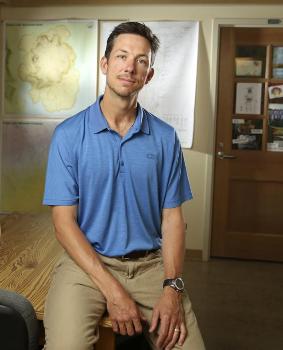Nov 28 2015
Lush greenery rich in Douglas fir and hemlock trees covers the Triangle Lake valley of the Oregon Coast Range. Today, however, geologists across the country are more focused on sediment samples dating back 50,000 years that were dug up by University of Oregon scientists.
 Joshua Roering, a geologist at the University of Oregon, directed a National Science Foundation-funded study that suggests much of North America's non-glaciated landscape was much colder than long thought and experienced erosion from frost-cracking at a rate some 2.5 times that seen today. Credit: Photo by Charlie Litchfield
Joshua Roering, a geologist at the University of Oregon, directed a National Science Foundation-funded study that suggests much of North America's non-glaciated landscape was much colder than long thought and experienced erosion from frost-cracking at a rate some 2.5 times that seen today. Credit: Photo by Charlie Litchfield
The sediment indicates that the mountainous region, which was not covered in glaciers during the last ice age, was a frost-covered grassy landscape that endured erosion rates at least 2.5 higher than today's, an eight-member team reports in a paper in the journal Science Advances.
The research raises the possibility that non-glaciated terrain across North America was similar to that found 40 miles northwest of Eugene. The findings also suggest that mean annual temperatures were about 11 degrees Celsius cooler than modern temperatures, and that frost cracking -- not rainfall -- drove erosion as the region began emerging out of the Last Glacial Maximum.
Core samples containing telling signatures of frost were drilled up from 200 feet below today's surface near Little Lake. The valley, also home to the much larger Triangle Lake, is the result of a massive landslide 50,000 years ago. Eroding sediment then continued to fill a large lake and transform the valley floor.
UO doctoral student Jill A. Marshall led the National Science Foundation-funded research under the direction of Joshua J. Roering, a professor in the UO Department of Geological Sciences.
"I remember running into Josh's office and interrupting him to exclaim with great excitement, 'frost cracking -- all of the paleo-ecological data suggests it had to be cold enough at Little Lake for frost cracking,'" said Marshall, now an NSF-supported postdoctoral researcher at the University of California, Berkeley. "And when the visual evidence in the core began to confirm our new hypothesis, it was exciting all over again."
Uncovering North America's unglaciated past
Materials in the cores showed "a transition from finely laminated red, brown and gray lacustrine clay, silt and sands to coarse lacustrine blue-gray sand deposits" at about 26,000 years ago. Lacustrine soils are those found in fresh-water areas.
Subsequent analyses led by co-author Daniel Gavin, a professor in the UO geography department, found that the older sediment samples contained needles of both Sitka spruce and subalpine fir. This unusual combination of species, Gavin said, suggests a cold parkland setting characterized by patches of forest and open meadow such as that found in southeast Alaska today.
The distribution of such frosty conditions, Roering said, may have stretched from Oregon to Georgia, and efforts to prove that are already under way.
"Modern-day erosion and landscape change is slow compared to what it was during cold, dry climate intervals when there were no Douglas firs around and the hills were covered by grassy meadows," Roering said. "So using modern climate and geomorphic processes doesn't help us understand how much of our surroundings were created. Rock properties, soil thicknesses, everything that makes the Coast Range grow trees today all may be benefiting from soils produced during that frosty period. This is a humbling discovery."
The research at Little Lake also has helped answer questions raised by previous sediment samples taken from a different location near Little Lake. That work, led by former UO geographer Cathy L. Whitlock, now a professor of earth sciences at Montana State University, had focused on ancient pollen sources to study erosion and wildfire events. The difficulty in identifying spruce-related materials to the species level had implied colder average temperatures, ranging from 7 to 10 degrees Celsius, in the past; the latter is about 18 degrees Fahrenheit.
"This new research has totally reset my earlier perception of the Oregon Coast Range as a well-studied, well-characterized model landscape," Marshall said. "The implications go far beyond the Oregon Coast Range. I now believe we are much closer to being able to characterize just how the past glacial interval influenced -- and in some places continues to influence -- earth surface processes in regions that were never glaciated."
Source: http://uoregon.edu/